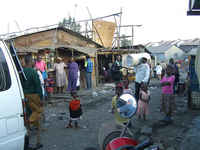The cancer of sub-standard housing is spreading round the world
In spite of international commitments, 1,600 million people all over the world are living in deficient housing, and in the developing South 828 million lack adequate water and sanitation services. In the Social Watch Report 2012, experts warn that these problems are aggravated by inequalities between and within countries, privatization, the disappearance of communal property, migration, forced eviction, land speculation and climate change.
According to UN data cited in the chapter “Housing, land and sustainable development”, by Miloon Kothari, ex United Nations Special Rapporteur on Adequate Housing, and Shivani Chaudhry, associate director of the Indian Network of Housing and Rights to Land, since 2000 the world’s urban population has swelled by some 60 million marginalized people, and the slum population is increasing by 10% a year.
The experts predict that “in the worst case scenario the world’s slum population will have increased from 1,000 million in 2005 to 1,600 million in 2020”. The World Health Organization (WHO) has calculated that more than 35% of the people on the planet do not have adequate sanitation services, and 70% of those affected live in rural areas.
Kothari and Chaudhry say that one of the factors underlying this situation is economic globalisation. It is true that “new and unprecedented sources of wealth” have been uncovered, but “inequalities in income and opportunities between and within countries” have led to more people “living in inadequate conditions”.
The experts explain that “the privatization of basic services” and the fact that governments are unable to provide access to water and housing are having “a disproportionately negative impact on the poorest and most vulnerable sectors of society”.
Moreover “spiralling speculation in land and property” is contributing “to the displacement of poor people” in urban and rural areas. The cities compete for investment capital and this leads to greater inequality which is causing “residential segregation” and “polarising society even more” in “a new form of apartheid”.
The expanding search in rural areas for minerals to exploit and power-generation locations has led to an unprecedented takeover of land for development and extraction mega projects, and these are severely threatening people’s livelihoods and food security.
Kothari and Chaudhry say that at the same time, States are ignoring “the importance of common property resources in urban and rural areas” and brushing aside “rights based on collective and community ownership”. As a consequence housing, standards of living, and the cultures of indigenous and other local communities are being destroyed.
The experts explain that “lack of investment” in these areas is causing emigration “on an unprecedented scale” and these people “end up living in precarious or inadequate conditions”, above all because they have “little or no access to basic services like water and sanitation”. In addition, there has been an alarming increase in forced evictions “in the name of ‘development’” to make way for urban renovation and gentrification projects and new infrastructure (mining, highways, ports and dams), and caused by “the acquisition of agricultural land for industry” and by wars.
To make matters worse, “on the world level there are no resettlement polices, or none that are based on human rights, for people who have been forcibly evicted”.
The study mentions another factor, the impact of climate change and the measures to alleviate its effects or adapt to the new situations. “The worst affected” by this phenomenon “are the poor in ‘less advanced’ countries, arid, semi-arid and Arctic regions, and small island-States, where predictions indicate there will be “widespread displacement and the forced relocation of vulnerable communities”.
A much-needed change of approach
In response to these worsening problems, civil society organizations all over the world have articulated the principle of “the right to the city”, promoted the concept of “land as a human right” and stressed “the need to recapture the social function of property”. This approach emphasises that “given the mutual inextricability of human rights”, the fact that States are ignoring rights to adequate housing and land “has resulted in a cycle of deprivation that impedes the enjoyment of several related human rights” including the right to food, water and health services “in the context of sustainable development”.
The report goes on to say that discarding this approach will lead to “more hunger, dispossession, homelessness, landlessness, and the degradation of the environment”. The impact of rights violations will be “particularly serious for women, children, indigenous people, coastal communities, forest dwellers, small farmers, landless workers and the urban poor”.
“The rights to housing and food of the millions of people living in shanty towns who depend directly on natural resources are now threatened by not having a secure environment (free of water and air pollution), environmental resources (forests, water masses) or means of subsistence”.
To overcome this threat it is essential “to secure access to natural resources and the means whereby communities can subsist, to use ‘green’ technologies and to implement ecological construction regulations. This means building houses that can stand up to natural disasters and locating them in areas that are safe and near places of work, education and health care”, and using materials that are indigenous and culturally appropriate”.
The experts agree that other necessary requirements are “rent security and protection against violence and eviction” and that States should “secure the prior and informed consent of the populations affected” by development projects.
Examples in various countries
In Serbia, there are urban planning projects in areas along the Adriatic coast, which today are home to two million people, that will provide housing for 17 million, and this will have “an enormous impact”. Urban development is also advancing into agricultural land. In the cities, gypsies and people who have been displaced do not have adequate housing or potable water. In rural areas soil degradation is contributing to increased poverty. In Croatia too, agricultural land is being used for building as part of urban planning policies.
According to the report from Honduras, deficient housing districts in the cities of San Pedro Sula and Tegucigalpa have undergone explosive growth because of migrations from rural areas. The population of the shanty towns in these two cities increased from 900,000 in 1990 to 1,283,843 in 2010. These people are living in unsafe conditions because their dwellings are made with bad quality materials and because of “weather phenomena that cause mudslides, floods and destruction”.
Poland does not have a housing policy for low income groups. Nearly one third of the population lives in overcrowded homes. More than 60% of the housing units are in need of major repairs and more than half are more than 40 years old. In general the buildings are of bad quality, and this means families have to consume more energy for heating.
In the Central African Republic there is accelerated urbanisation that is reducing the area under cultivation to make way for housing, and as a consequence houses are being built in an anarchic way, pollution is concentrated, soils are being degraded, the hydro-geologic regime is changing, the savannah is encroaching and pre-desertification is endemic. Some districts in the capital Bangui have electricity only four days a week and access to potable water is extremely limited.
In Malaysia a whole area of tropical forest is being flooded to build a huge hydroelectric dam and at least 15 communities have been evicted. In Bangladesh it is predicted that climate change will not only reduce agricultural production and the potable water available but raise sea levels and displace millions of people unless existing coastal polders are reinforced and others built.
In Mexico City in February 2011 thousands of people protested against a range of mega projects that would destroy trees and green areas and irreparably damage the lungs of the city, and against building in areas that are protected, that have high environmental value or that would occasion serious damage to aquifers.
In Guatemala, Nigeria, Senegal and Thailand the use of wood for building is contributing to deforestation and the consequent aggravation of bad conditions of life in local communities. In Sri Lanka this phenomenon is linked to the reconstruction of houses and infrastructure destroyed by the 2004 tsunami.
Source
Social Watch Report 2012:
http://bit.ly/skL4l4

